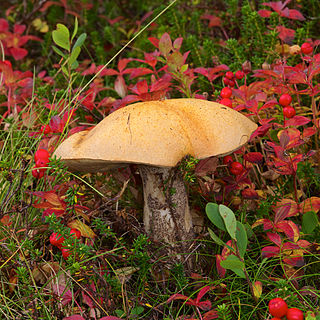Top Qs
Timeline
Chat
Perspective
Leccinum versipelle
Species of fungus From Wikipedia, the free encyclopedia
Remove ads
Leccinum versipelle, also known as Boletus testaceoscaber, dark-stalked bolete, or orange birch bolete, is a common species of mushroom that may be edible when given the right preparation. It is found below birches from July through to November, and turns black when cooked.
Remove ads
Taxonomy
Leccinum is a genus of fungi in the family Boletaceae. It was the name given first to a series of fungi within the genus Boletus, then erected as a new genus last century. Their main distinguishing feature is the small, rigid projections (scabers) that give a rough texture to their stalks. The genus name was coined from the Italian Leccino, for a type of rough-stemmed bolete.
Description
The cap is broadly convex, buff to yellow-orange or ochre, bright red-brown or brick red. It is felty and grows up to 15 centimetres (6 in) in diameter.[1] The flesh is white to pink, when cut staining reddish and then changing to avellaneous and finally fuscous. Tubes are 8 - 22 mm long, yellowish white to brownish grey, violaceous to greyish when bruised. Pores measure 0.5 mm in diameter, greyish white to grey ochre, discolouring brownish when bruised.[2]
The stipe is firm, long and slender, white, lightly to densely covered with fine (sometimes on the stipe base more coarse) greyish to blackish, sometimes whitish, squamules.[2] Stalks are up to 15 cm tall[1] by 3.5 cm wide, whitish, and with many raised, black dots.
The spores are brown, or smokey to blackish-brown, fusiform, (9.0—) 11.5—16.5 x 3.5—4.0(—5.0) μm.[2] Spore print is yellow-brown to olive.[citation needed]
- Orange birch bolete (Leccinum versipelle), New Jersey, US
- Stem of a Leccinum mushroom, showing the distinctive scabers
Remove ads
Distribution and habitat
Leccinum versipelle fruits on the ground solitary or gregarious, with ectomycorrhizal association with Betula in forests and heathland, on sandy, slightly acidic, loamy soils.[2][3] It can be found across Europe from August to November.[1]
Edibility
Leccinum versipelle is edible cooked.[1] It is mildly toxic (causing nausea and vomiting) unless given proper heat treatment: frying or boiling for 15–20 minutes is necessary. It is commonly harvested for food in Finland,[4] Latvia, Lithuania, Estonia, Belarus, southeast Alaska and Russia.
References
Wikiwand - on
Seamless Wikipedia browsing. On steroids.
Remove ads



